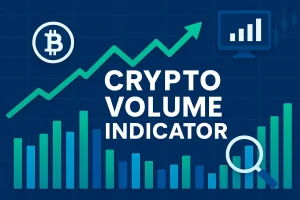Crypto Volume Indicator: Real-Time Trading Guide
The Crypto Volume Indicator: Reading the Market’s Pulse in Real Time
Cryptocurrency prices whip around for a thousand reasons, yet nothing betrays sudden conviction—or fear—faster than a surge in trading volume. Master that heartbeat and you’re already a step ahead of the next candle.

1. What Counts as “Volume” in 2025
“Volume” used to mean a simple book of filled orders on a single exchange. Today it’s a hydra: spot desks, permanent swaps, DEX pools, cross-chain routers, even dark liquidity inside MEV bundles.
The Modern Ingredients
- CEX Tape – Centralised order books; still the fastest price discovery for majors.
- DEX Liquidity – AMM swaps, limit orders on Layer-2, and aggregator routes.
- Bridge Flows – Exits from an L2 are usually large and lead ahead of a chain-hop chase.
- Whale Wallets – One address can burst “real” volume without even touching an exchange.
2. Why Volume Still Moves Markets
Price will fool you; volume won’t. A sudden 3 % spike on light volume? Probably noise. The same activity on 10 × normal volume? A big player placed their wager.
Recent evidence: When spot ETH reached $4 k in March 2024, the authentic story was a 480 k ETH deposit onto CEX hot wallets three hours beforehand. A supposed bearish decline in August 2024 rebounded within minutes due to DEX LP trading volume never skipping a beat.
3. On-Chain vs. Exchange Prints
| Source | Pros | Blind Spots |
|---|---|---|
| CEX order books | Tight spreads, clear depth | Hidden from-chain accumulation |
| DEX swaps | Fully transparent, viewable in real time | Wash-trading in thin pools |
| Token transfers | Captures OTC deals and bridge hops | Spam & airdrop bots muddy counts |
4. Building a Unified Volume Indicator
Step 1 – Fetch the feeds
# pseudo-code (Python)
from duneapi import DEXVolume
from ccxt import binance
cex_volume = binance.fetch_ohlcv('BTC/USDT', '1m')
dex_volume = DEXVolume('btc', interval='1m').frame()
Step 2 – Normalise units
Convert each source to base-asset units (BTC, not USD) before adding.
Step 3 – Adjust for Gas & Slippage
On-chain transactions pay for gas; forget that overhead and you’ll overestimate conviction on busy hours.
Step 4 – Smooth but Never Lag
A 20-period exponential moving average filters noise without hiding the spike you care about.
Pro tip: Share the indicator as a TradingView script with a JSON endpoint. Traders mess around, devs integrate, and you receive backlinks whenever someone loads the chart.
5. Putting the Signal to Work
Momentum Trades
Breakouts on rising united volume have extra kick. Place alerts at 150 % of the 14-day median.
Mean-Reversion
When price tanks on falling volume, smart wallets are typically on the sidelines; the rebound is normally steep.
DAO Treasury Management
Volume spikes leading up to governance proposals signal speculative positioning. Treasuries hedge by selling covered calls during such windows.
6. Rookie Pitfalls (and Quick Fixes)
- Blind to Wash-Trading Loops – Filter DEX volume by wallets over time.
- Bridge Spam Counting – Leave out micro-transfers in airdrop season.
- Over-smoothing – A 50-period average obscures new data; apply 10-20 unless purely swing trading.
- Forgetting Stablecoin Supply – Increasing USDC/USDT float can overstate volume; plot circulating supply on the same graph as price.
7. Where the Metric Is Headed
Real-time proofs are coming. EigenLayer derivatives of restaking already pass live volume data into attestation networks, and Farcaster Frames send charts directly into social feeds. Watch for Google Discover to incorporate “living” indicators once your JSON-LD blobs have settled their lineage.
FAQ
Volume Indicator 101
What is the primary difference between OBV and combined volume?
On-Balance Volume (OBV) tracks price-volume momentum on one venue. An indicator that is a combination of CEX, DEX and standard token transfers provides a broader, smoother stream of data.
Can a whale move distort the indicator?
A massive wallet transfer will show up, but normalisation against single wallet and against 30-day averages keeps it grounded.
How often should I refresh the data?
For intraday trades, a 1-minute pull does not use up too much of your API allotment while keeping you current. Swing traders work with 15-minute snapshots.
Why do you normalize all your data to base-asset units?
USD prices inflate when stablecoins print. In terms of BTC, ETH or token unit, inflation noise is removed and pure trading appetite is shown.
Conclusion
A single-source line series is 2017 tech—mash up order books from CEX, DEX swaps and on-chain activity for the real signal. Normalize units, gas adjust and search for spikes that hit before price. Market your indicator as a shareable widget and market will do half the marketing for you.



